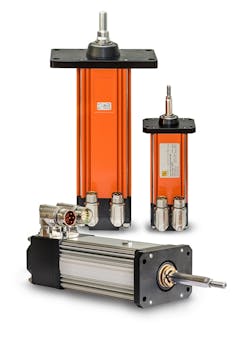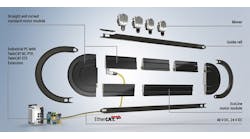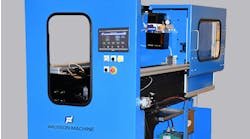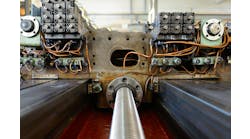"Creating an actuator design based on technologies used and proven in nuclear power plants is certainly a good starting point," says Daniel Stankovich, DA Series actuator product manager, Diakont. Diakont’s DA Series actuators combine a precision-machined roller screw, manufactured in-house and a high-force permanent magnet synchronous motor (PMSM), all packaged together in a small compact space envelop for use in a variety of critical industrial applications.
"Diakont was incorporated in 1990 in Saint Petersburg, Russia," continues Stankovich. "From the start, the company established market share in radiation-tolerant cameras for the nuclear power plant sector.” For the next 25 years, Diakont steadily increased capabilities in various services and products with a focus on the energy sector: nuclear power, natural gas and oil.
These products and services expanded from radiation-tolerant cameras to inspection robots for pipeline-integrity projects. In 2008, Diakont supplied its first motion-control system for nuclear power plants. This system utilized dual-redundant roller-screw actuators coupled with precisely engineered control system to handle the plant’s steam turbine. These units incorporated fail-safe features to prevent turbine overspeed, which is extremely dangerous and can cause expensive damage to the turbine. The actuator controlled a pilot valve adjusting steam flow to the turbine. This also required precise control and fine tuning of the steam to match the grid frequency.
Nuclear-power-plant operators expressed interest in the actuator, notes Stankovich. "Diakont, having developed the capabilities to produce demanding actuators, set out to create a mass-produced actuator based on roller screws for the manufacturing industry," he says.
Also read: The Straight Skinny on Linear Motion
This product line is based on years of technology development and now approaching a million hours of proven operating life in the most demanding applications, states Stankovich. The Diakont DA Series actuator is Diakont’s first offering of a mass-produced product that is available for customers outside of the energy industry.
A well-integrated design
"The new DA Series is an electromechanical actuator that utilizes an integrated motor design, as well as an inverted roller-screw transmission mechanism," explains Stankovich. The DA67 actuator has a continuous force rating of up to 600 lbf and has a price that is on par with similar ball screw actuators. The actuator incorporates several feedback options including a standard resolver, an incremental encoder or an absolute encoder. The motor is a high-pole PMSM variation that minimizes cogging torque and is designed for high-performance servo applications but can run with or without position encoders. Diakont also has more powerful models on the product roadmap (DA99 and DA140) which will generate forces of up to 8,000 lbf.
Call 858/551-5551, email [email protected] or browse to www.diakont.com.
A wide variety of stepper-motor and servo-motor drives are available to run the PMSM. "Our motors are compatible with most of the servo drives on the market," notes Stankovich. “And the motors are compatible with many available drives including Siemens, Elmo, Kolmorgen, Delta, Advanced Motion Control and others. Diakont can provide tech support and recommend drives and connections. This includes motor and resolver or encoder connections and cables."
While this is a precise and powerful actuator with an accuracy of approximately 20µm at 600 lb of thrust, a key differentiator is ease of lubrication. "The design allows the user to replace lubrication without removing the unit from the machine,” explains Stankovich. “Competitors typically require the users to stop the machine, remove the units, disassemble the actuator, re-lubricate the screw, reassemble the actuator, reinstall the actuator and calibrate the machine in order to begin operation. Not all actuators require it, but, in applications that do, it's an important feature to eliminate removal and disassembly."
Simply pump out the old grease and pump in the new. Diakont offers this as a service where it can be done without removing the actuator from the machine. Other actuators often need to be removed from the machine and sent back to the supplier for service. Performing maintenance with the actuator on the machine reduces downtime. In manufacturing, output is a driving force for success.
Rolling in better technology
Because Diakont had already created its own thread designs and roller-screw actuators for lower volume, but higher value projects, it was an easy decision to develop a solution that can reach markets beyond the energy industry while still remaining a core competency of Diakont.
"Roller-screw technology has been around, but Diakont introduced performance upgrades and differentiators that push the product further," says Stankovich. One of the big advantages is the accuracy of the machining. "We have processes in place to ensure that DA Series actuators are machined to the highest accuracy standards."
For the most part, roller-screw technology and ball-screw technology provide the same basic accuracy, comments Stankovich. But it goes a step further than that. "The roller screw has additional contact area, better load capacity and longer life, which can make it more desirable for an OEM,” says Stankovich. “There is much more surface area to spread out the load and wear surfaces. With a greater number of contact points than ball-screw solutions, roller screws provide increased load capacity and rigidity. The ball bearings may cause pitting of the ball screw, but the rollers screw eliminates this problem."
Fit for distance
The Diakont product incorporates a turnkey solution with the motor included in the unit, which allows designers to satisfy space constraints. Also, due to the roller-screw component replacing a ball-screw component, designers can increase reliability and longevity of their designs. The high pole count of the PMSM provides industry-leading repeatability as well.
"Roller-screw actuators are ideal for critical applications such as robotic servo weld guns, precision semiconductor equipment, servo presses, injection molding, CNC machines, packaging equipment and a wide variety of discrete manufacturing applications," notes Stankovich. "Replacing a pneumatic weld gun with a servo weld gun in a spot-welding application provides highly repeatable welds due to the servo control of the actuator."
With travel speeds of up to 39 in/s, the actuator is designed to work well in packaging pushing and slicing applications. “The combined accuracy and speed work well in yogurt injection, stamping, consumer, food and pharmaceutical applications," continues Stankovich.
Diakont could even add a drive to the actuator in the future, says Stankovich. “With the motor built-in, the actuator is more compact than ball-screw actuators driven by an externally mounted servo motor with belt or gearing," comments Stankovich. "The actuator delivers high force and compact size—better force per volume, and it solves a specific need. While it may not replace the inexpensive pneumatic options in the market, the actuator's main target is replacing ball-screw and hydraulic actuators."
The Diakont DA Series actuator is the first attempt at a mass-produced product that is available for customers outside of the energy industry.







